Ball pythons are one of the most recommended beginner snakes because they are docile, friendly, long-lived, and only grow to be around 3-5 feet.
However, deciding to purchase a ball python is only the first step.
You will then need to choose from thousands of different ball python morphs.
Ball python morphs are selectively bred by isolating mutations that cause different pattern or color variations. We estimate there are now over 4,000 different morphs in captivity!
If you are considering adding this snake to your home, read on to learn about the 50 most popular ball python morphs and their color and pattern variations…
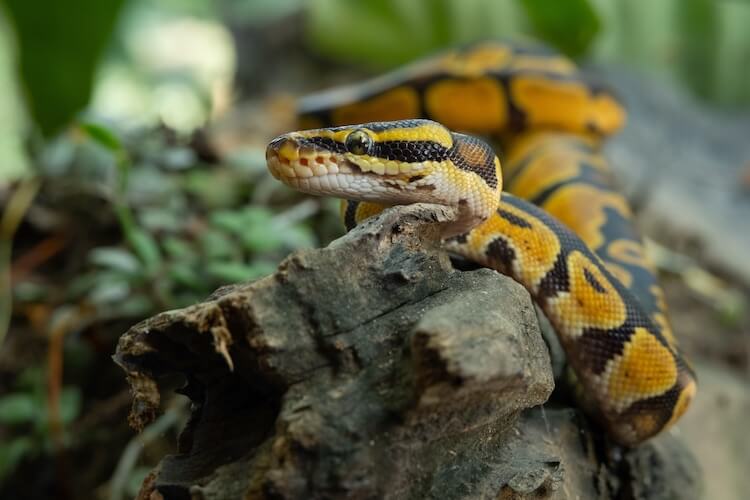
What Are Ball Python Morphs?
Ball Python Morphs are Ball Python snakes that have been selectively bred for a specific color or pattern appearance.
Morphs are bred by specialized snake breeders who try to isolate mutations found naturally in the wild. They use selective breeding to produce especially vivid and interesting color variations.
The genes that make up ball python morphs are passed on through inheritance – just like with humans. That is why genes can be dominant, recessive, or codominant. Breeders look to exploit these three genes to produce different morphs:
- Codominance – occurs when the offspring inherits two alleles (alternative forms of a gene) that have incomplete dominance. This allows a unique combination of visible traits.
- Dominant – dominant alleles hide the effects of the second allele and “dominate” the pattern or coloration.
- Recessive – recessive alleles are “hidden genes” that only show up when they are paired with another recessive trait.
Below is a list of key terms you should get to know before exploring our list of Ball Python Morphs:
- Alien Heads – distorted heart-shaped blotches containing two symmetrical dark spots, like a pair of eyes.
- Basic morph – Base morphs are naturally mutated snakes that occurred in the wild or have a high likelihood of having originated there.
- Blushing – the faded color gradient present in the base color of many snakes.
- Designer morph – when a breeder selectively breeds two or more basic morphs to create a pattern that has an almost 0% chance of occurring naturally.
- Flaming – lighter coloration bordering the sides of keyholes and alien heads around their base.
- Keyholes – the balloon-shaped spots on the side that typically have a dark central spot.
A-Z Ball Python Morphs List
| Morph | Color | Price | Popularity Rank |
|---|---|---|---|
| Acid | Dark brown or black base color with golden brown spots | $1,500 | 44 |
| Albino | Bright yellow and white snake with bright red eyes | $250-$400 | 3 |
| Axanthic | Gray, black, white, brown, and silver colors | $200 | 6 |
| Banana | Strong yellow colored blotches and spots against a tan base color | $150-$250 | 2 |
| Black (Black-Backed) |
A thick, unbroken stripe of concentrated pigment running down their spines | $50-$100 | 21 |
| Black Pastel | Dark, dusky black and shadowy gray base colors | $1,000 | 17 |
| Blue-Eyed Leucistic | Pure white with blue eyes | $800-$1,000 | 46 |
| Blue-Eyed Lucy | Faint yellow dorsal stripes with blue eyes | $700 | 48 |
| Bongo Pastel | Black base color that fades to white along the sides of the belly | $300-$500 | 49 |
| Bumblebee | The brightest yellow ones are called “Killer Bees” | $450 | 11 |
| Butter | Soft, creamy-yellow markings highlighted by a caramel-brown | $100 | 22 |
| Candino | Light pink or lavender base color and a bright yellow blotched pattern | $300 | 38 |
| Candy | Dark lavender, gray, and beige base colors while keeping the bright yellow patterning | $350 | 41 |
| Champagne | Dark brown in color with a light stripe down their spine | $200 | 30 |
| Chocolate | Dark chocolate-brown base colors with caramel colored keyhole and alien head spots | $100-$250 | 39 |
| Cinnamon | Rich brownish-red color and bronze rings | $450 | 18 |
| Clown | Tan and brown with copper undertones | $200 | 12 |
| Coral Glow | Dark lavender base coloration with bright orange blotches | $250 | 29 |
| Dreamsicle | White or pinkish in color with “clouds” | $2,500 | 34 |
| Enchi | Orange-tinted sides and a rounded pattern at the back of the head that shows some blushing | $100 | 15 |
| Fire | Coffee-brown with a thick, tan banding pattern | $100-$400 | 13 |
| Fire Ivory | Pink-lavender base color with graying blushing | $375 | 47 |
| Ghi Ball Python | Patternless, light colored bellies and a black base color | $100 | 50 |
| Ghost | Lighter tans, yellows, and even have gray flaming along the sides | $100 | 28 |
| Highway | Copper-brown to gray-brown | $550-$650 | 33 |
| Ivory | Patternless, pinkish-white color. They have a thin yellow stripe down their spine and jet black eyes | $200-$300 | 27 |
| Lavender Albino | Lavender base color with a well-defined, bright yellow pattern | $400 | 19 |
| Lemon Blast | Fine-lined, complex linear patterns of dark brown and black | $200 | 32 |
| Lesser | Dark brown, blushed-out base color that lightens towards the belly | $125 | 20 |
| Mojave | Dark brown to bluish-black | $100 | 7 |
| Mystic | Dark brown-black base that fades to a tan color towards the belly | $150 | 25 |
| Pastel | Blushing brown base color and clean white | $75 | 5 |
| Pewter | Light brown or tan base color with a thick stripe along the spine | $200 | 23 |
| Phantom | Black base color that fades to tan as it approaches a white belly | $100 | 37 |
| Piebald | White base with patches of color that are filled with an erratic pattern | $300-$400 | 4 |
| Pinstripe | Light brown to copper color with a thick, patternless stripe | $100 | 14 |
| Purple Passion | Lavender-pink bodies with patternless sides | $400 | 16 |
| Red | Deep red undertone blotches | $100 | 31 |
| Ringer | A small spot or ring of white near the end of their tail | $150 | 45 |
| Scaleless | Totally scaleless with just belly scales | $2,500 | 9 |
| Spider | Tan-brown base colors that pale along the spine | $150 | 1 |
| Spotnos | Faded light brown spotting pattern on a dark alien head | $150 | 40 |
| Stormtrooper | White with gray and black markings was produced | [n.a] | 26 |
| Sunset | Deep auburn-red with copper colored spotting | $1,000-$1,500 | 10 |
| Super Blast | Hazy, bright pastel yellow color | $400 | 43 |
| Tiger | Light yellow color that fades to an orange hue along the sides | $200-$400 | 42 |
| Vanilla | Blushed-out brown base with a faded head | $100 | 24 |
| White | No pigment with standard dark eyes | $650 | 8 |
| Woma | Brown sides that gradually lighten towards the spine | $250 | 36 |
| Yellow Belly | Yellowish tint on their bellies and a speckled pattern bordering their scutes | $50 | 35 |
Top 50 Ball Python Morphs
1. Spider

The Spider morph entered the market in 1999 as a unique dominating gene.
Spider morphs have tan-brown base colors that pale along the spine. The color tends to become pale and specked along the sides of the belly.
They have thin, dark banding and spots along their bodies and distinct black markings on their head and face.
Ranked as the most popular morph, these snakes are in high demand and can be purchased for $150.
2. Banana

Banana ball pythons possess a codominant gene first revealed in a clutch in 2003.
The first snake from that clutch was sold for $25,000!
Since then, breeders have been producing these incredible morphs for enthusiasts.
They have strong yellow colored blotches and spots against a tan base color. Sometimes they have dark freckles across their faded yellow bodies.
Banana balls sell for $150-$250, depending on gender and pattern.
3. Albino
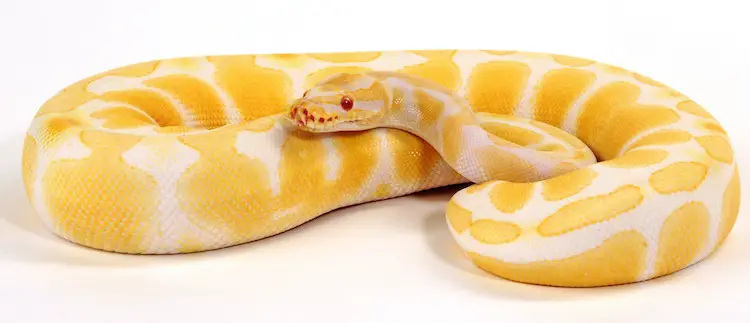
Hatched in 1992, the Albino ball python was the first-ever recessive morph.
Albinism means the snake is “amelanistic” and is not able to produce brown, black, red, or orange pigments in its scales. That is why Albinos are normally patterned bright yellow with bright red eyes.
Albinos are loved for their high contrast patterns that typically fade out to various shades of yellow.
As the first affordable recessive morph, you will find them on sale for $250-$400, depending on their age and contrast level.
4. Piebald
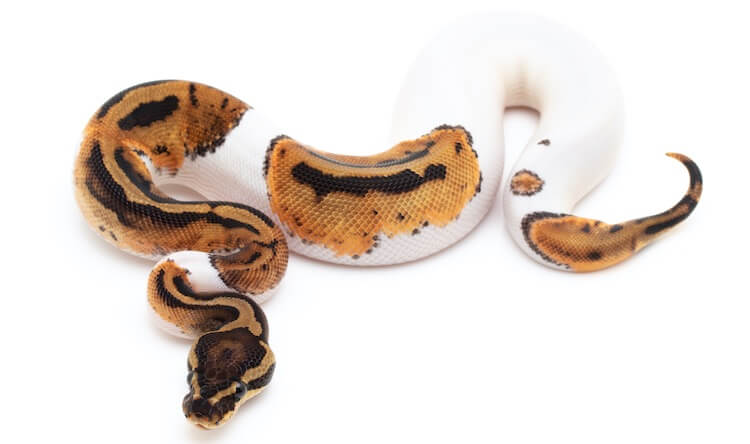
The Piebald is one of the most easily recognizable morphs.
First bred in 1997, the Piebald’s variable patterns are caused by a recessive gene.
They always have a white base with patches of color that are filled with erratic patterns. The ratio of white to colored patches seems somewhat random too, though almost all Piebalds have a normal head.
Most Pieds can be purchased for $300-$400 depending on the amount of white present in the pattern.
5. Pastel (Super Pastel)
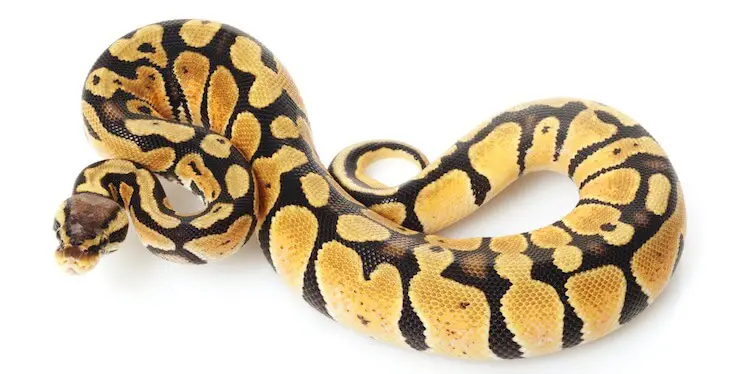
The Pastel is a basic morph that was first named the “Pastel Jungle” in 1997.
These snakes have a normal pattern with a blushing brown base color and a clean white belly. Their eyes are a unique pale green color and they have white lips on a pale head.
You can purchase a Pastel for $75.
When two Pastel morphs are bred, a totally different snake is produced.
Super Pastels have a reduced, yellow pattern with a purplish-blushing color often called “Purple Haze.” They have an erratic pattern with some banding and more “keyhole” blotching.
Expect to pay $150 for a Super Pastel.
6. Axanthic
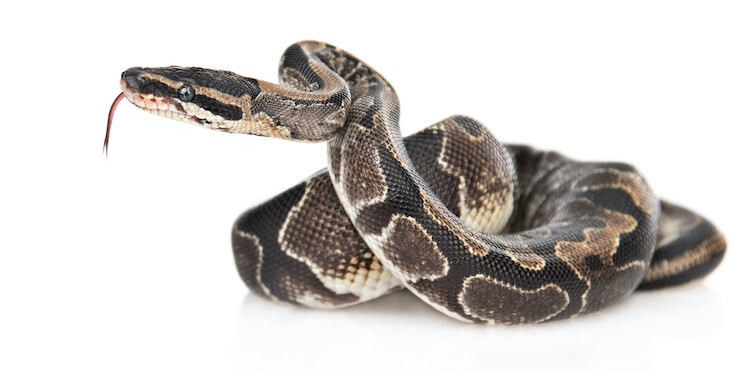
Axanthic ball pythons lack red and yellow pigments in their scales (similar to how albinos lack brown, black, red, or orange pigment).
This leaves the Axanthic with varying gray, black, white, brown, and silver colors.
They have a high contrast normal pattern that tends to turn brown with age.
Since the recessive trait was discovered in 1997, these snakes have been sold to breeders around the world to create more morph variations.
You can buy an Axanthic for $225.
7. Mojave
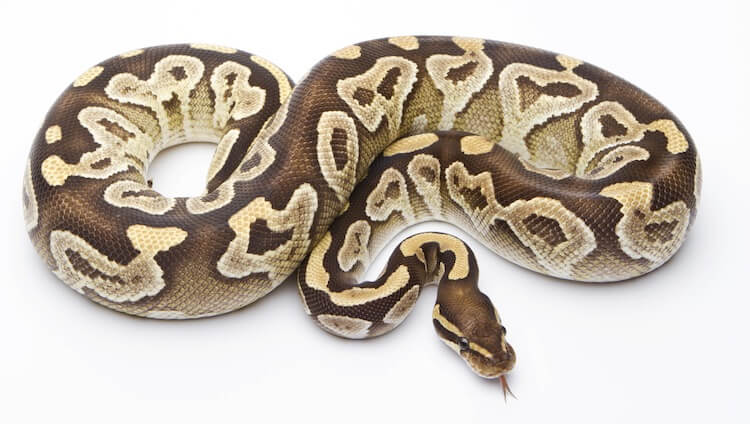
Another one of the most recognizable morphs, the Mojave was first bred in 2000. They are used for their gene codominance to produce incredible patterns – like the Blue-Eyed Lucy.
This Ball Python typically has a base color of dark brown to bluish-black.
Their pattern is a combination of deep browns and vibrant yellows with cream-colored flaming.
The “Mojave Pattern” is similar to the normal alien-head but has flaming and contains only a single small keyhole mark.
8. White
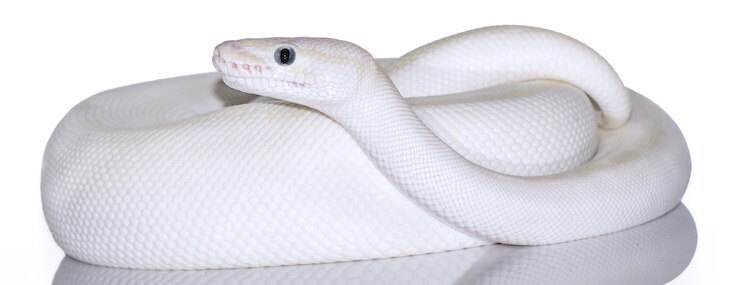
The White ball python was first discovered in 2007 by accident.
Interestingly, the first snake was discovered accidentally in a clutch that hatched on the breeder’s wedding day, hence the name “White Wedding.”
White Wedding pythons are considered the cleanest of all the leucistic patterns. They have no pigmented scales but retain the standard dark eyes.
Since 2007, these snakes have been successfully reproduced and can be purchased for $650.
9. Scaleless
The Scaleless is the most unusual of all the morphs in this list.
Scaleless ball pythons were first bred in 2013 from Scaleless-Head morphs.
As their name suggests, have skin instead of scales. The amount of scales they have can vary from totally scaleless to just a few skin patches, but all of them have belly scales. Without belly scales, called scutes, they would be unable to move across the ground.
You can bring one of these scaleless snakes into your home for $2500.
10. Sunset
The Sunset is an unusual morph that was first bred in captivity in 2012 from a basic morph.
This deep auburn-red snake has copper colored spotting and a dark red head. They are completely unique and unlike any other morph in this list.
The first Sunset morph was sold for $70,000.
As the gene is now consistently reproduced, the price for this snake has dropped to $1000-$1500.
11. Bumblebee

The Bumblebee ball is a very intricately patterned snake bred from the Pastel and Spider genes.
They are mostly tan-yellow with thin black spots and stripes and varied specks of white. The brightest yellow morphs are called “Killer Bees” and retain their color into adulthood, unlike most snakes that fade with age.
Many keepers love Bumblebees for their gorgeous patterns.
Some breeders use the Bumblebees to provide more vivid colors in other morphs.
Darker variations of tan-yellow are $175, but a Killer Bee costs $450 depending on the level of contrast.
12. Clown
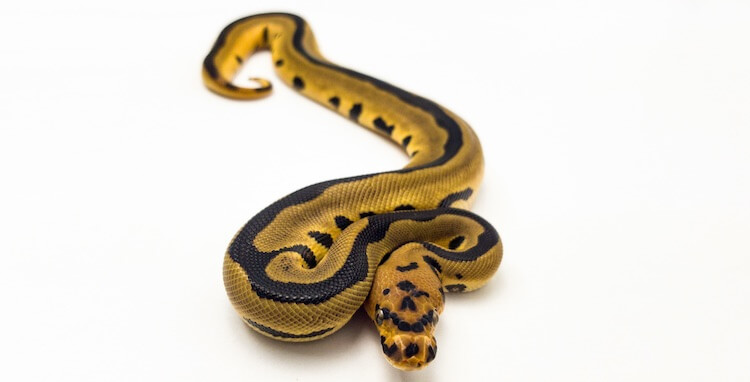
Clown ball pythons possess a recessive mutation that affects both their color and pattern.
They are normally tan and brown with copper undertones that fade towards their belly and mellow with age.
This morph also has a reduced pattern with a dark, wide dorsal stripe.
The Clown has a unique head with a complex pattern of light and dark shades.
Interestingly, this snake is known as the Clown because the first one found had a teardrop-like spot underneath its eye.
Since their discovery in 1999 they have been called Clowns and are sold for $200.
13. Fire (Super Fire)

In 1995 the first Fire morph was bred. They are a mix of codominant genes that create a coffee-brown snake with a thick, tan banding pattern.
You can purchase a Fire for around $100, however a Super Fire can be as high as $400.
When mated together, the codominant gene causes colors to be “fired up” and a Super Fire is born.
The first Super Fire was bred in 2002.
Super Fires are commonly known as Black-Eyed Leucistic pythons and are white with various shades of yellow spots along their spine with red pupils.
14. Pinstripe
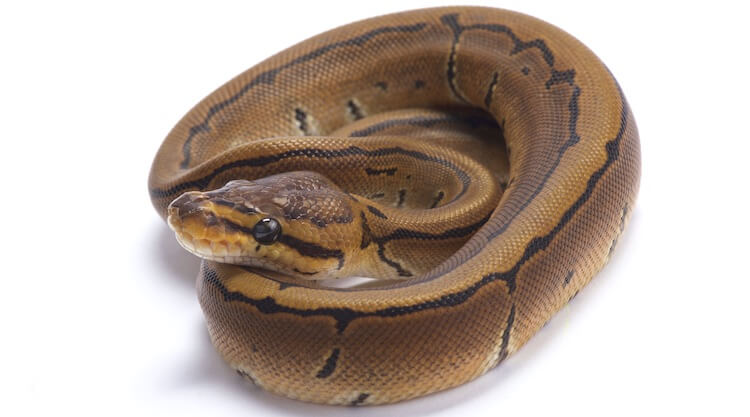
First named in 2001, the Pinstripe morph is loved by many snake owners for the dominant stripe along their spine.
Pinstripes are popular with breeders because they are frequently used to mate with other morphs to reduce patterns and create a more pronounced spine.
For $100 you can purchase a Pinstripe.
These snakes are typically a light brown to copper color with a thick, patternless stripe that stretches from the back of the head all the way to the tail tip.
They also have thin stripes perpendicular to the pinstripe with some light-colored flaming.
15. Enchi
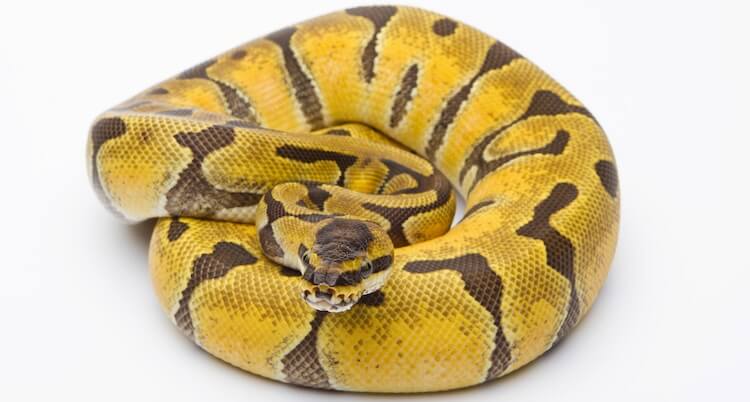
The Enchi morph was first found as a breeding pair in Ghana, Africa in 2002.
A standard Enchi can normally be purchased for $80-$100.
Compared with normal ball pythons, Enchies are more vivid and have orange-tinted sides with a rounded pattern on the back of their head that shows blushing.
Their genes are codominant when bred to other morphs – so the patterns of their offspring are more defined.
In a hatchling, the color difference is almost too subtle to notice, but it will intensify with age.
16. Purple Passion
The Purple Passion morph is the result of a codominant gene produced by mating the Mojave and Phantom morphs.
They were first bred in 2007 and sell for $400.
Purple Passions have lavender-pink bodies with patternless sides.
They also have a light, off-white striping down the spine with dark-colored eyes. Their lavender-pink bodies vary in intensity, and some have circular spots with keyholes, though that is uncommon.
17. Black Pastel (Super Black Pastel)
The Black Pastel morph was first bred in 2002. After the first clutch was born, it was determined that the morph is a codominant gene.
They are currently being sold for between $150-$200.
This morph is known known for its dark, dusky black and shadowy gray base colors. Their pattern has a lot of blushing too.
These snakes have a completely unmarked belly.
Breeding two Black Pastels produces a Super Black Pastel, which can be solid black or dark with some visible patterning.
Super Black Pastels are typically high contrast snakes with rusty colored blotches and a black base.
18. Cinnamon (Super Cinnamon)

Cinnamons were first discovered in 2002 and are the result of basic codominant genetics.
They tend to be a rich brownish-red color and have bronze rings outlined in black shadow.
The average Cinnamon ball is normally $75, however, a Super Cinnamon is far more expensive costing $450.
When two Cinnamons are crossed, a Super Cinnamon is hatched.
Supers are a solid, dark brownish-red that fades with age to take on a more cocoa color or even a dusky gray-brown. They are completely patternless with a light, unmarked belly.
Because they fade to a cocoa color these morphs are also called black ball pythons.
19. Lavender Albino
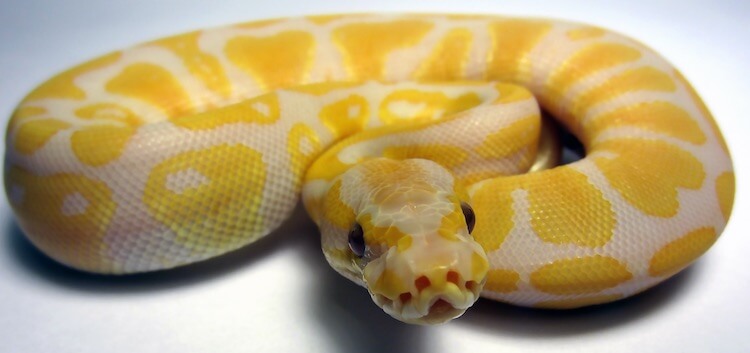
The Lavender Albino morph was first discovered in 2001 and sold for $40,000!
This basic morph is a combination of recessive Albino and Lavender traits. They are a color mutation.
These snakes typically have a lavender base color with a well-defined, bright yellow pattern and red eyes.
Most have a very high color contrast and sharp clarity in their pattern that makes them very valuable.
Now that breeders can consistently produce this morph they sell for $400.
20. Lesser
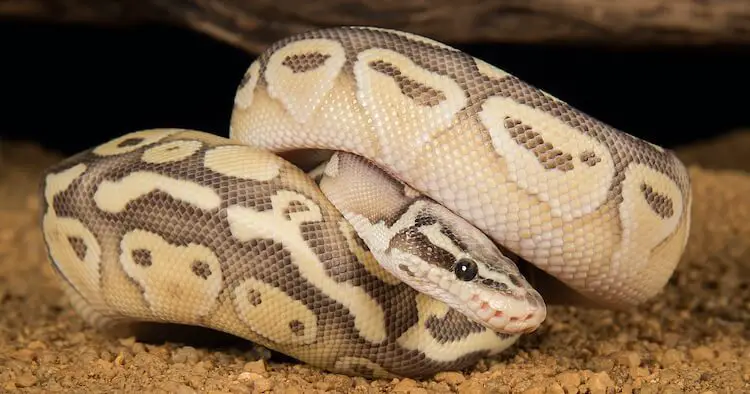
The Lesser is a basic morph that takes on a codominant role when bred. The first Lesser was bred in 2001 and sold for $30,000.
Lesser Ball Pythons have a dark brown, blushed-out base color that lightens towards the belly. They have light yellow spots along the sides and spines with almost no spots or disruptions within the balloon-splotches.
Their head appears normal, just slightly lighter brown.
This morph was truly unique at creation, however they are now easy to breed and have a very similar appearance and color intensity. This makes them one of the cheaper morphs on this list at $125.
21. Black (Black-Backed)
The Black-Backed ball python’s origin is unknown, they are likely a wild caught snake.
These snakes have an almost normal pattern. Yet, unlike normal varieties, these have a thick, unbroken stripe of concentrated pigment running down their spines.
This dominant gene is known to be passed on to around half of its offspring, however, it has yet to be isolated for selective breeding.
Without knowing the gene, these snakes are known as “super normal” and only cost $50-$100.
22. Butter

The Butter ball is a calmer variation of the yellow morphs that costs $100.
It is a basic mutation that causes soft, creamy-yellow markings highlighted by a caramel-brown.
Their mellow colors descend directly from the wild.
They were first isolated in 2001 when careful breeding determined they possess codominant genes. Two Butters bred together to create Super Butters.
Some of the Supers are pale yellows, but others are actually Blue-Eyed Lucies. It can take several generations and a bit of luck to obtain Blue-Eyed Lucies from pure Butters!
23. Pewter
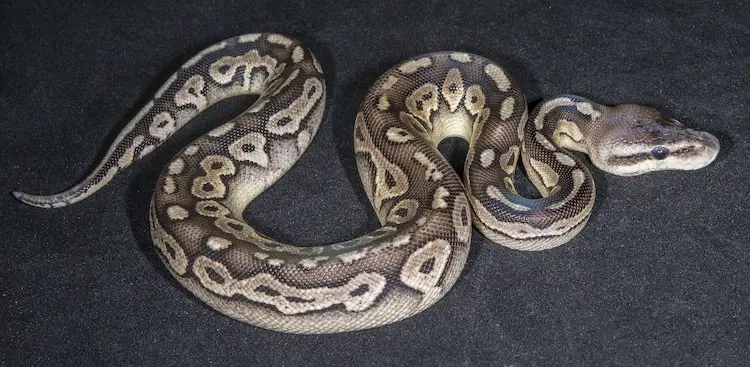
The Pewter morph is an interesting combination of the codominant Pastel and Cinnamon genes.
These ball pythons typically have a light brown or tan base color with a thick stripe along the spine. They tend to have golden yellow keyhole patterns with dark brown or black centers and outlines. Some may have spots or more erratic patterning.
The color scheme is uniform for all Pewters.
This designer morph was first bred in 2003 and can be purchased for $200.
24. Vanilla
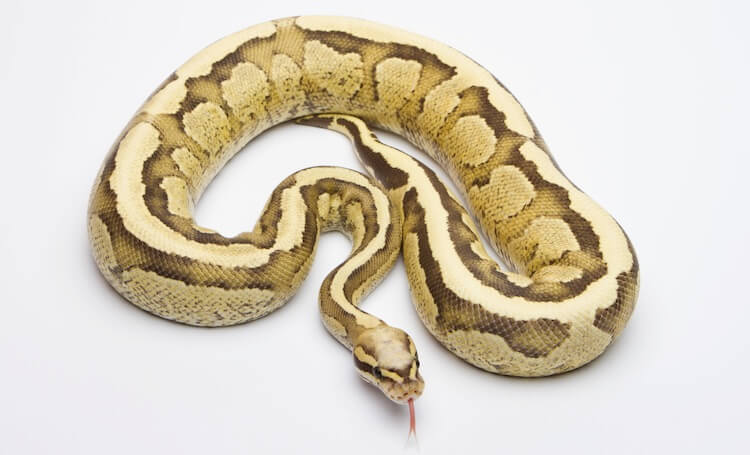
Despite what their name suggests, this snake is not Vanilla!
A beautiful array of brown shades define the Vanilla ball python, but it can affect their offspring differently. Vanillas bring out vibrant colors in other morphs so they are commonly used by breeders. Because of their popularity with breeders this morph costs $100.
The codominant gene takes a normal pattern and brightens with a blushed-out brown base and a faded head.
Vanillas also have a light belly color.
25. Mystic
Created in 2005, the Mystic ball python is a very rare morph and becomes increasingly unique with age. They are all first born with a dark brown-black base that fades to a tan color towards the belly. They often become a purplish-gray color with age.
This pattern is typically compared to a Mojave but lacks the distinct flaming pattern.
The keyhole blotch pattern often takes on a bronze-orange to gold color and has little to no alien head shapes. Their head tends to be very dark with no blushing and the morph only occasionally leads into a pinstripe.
If the idea of a color-changing snake interests you, you can buy a Mystic morph for $150.
26. Stormtrooper
The Stormtrooper was an accidental morph bred in 2015.
It was intended to be an Axanthic x Pastel snake (a fairly common morph) but a mostly white snake with gray and black markings was produced.
Over time, the Stormtrooper experienced a “darkening” event. The melanin production in the scales increased and the black pattern started overtaking the white portions of the snake.
Called the “darkness” gene, the Stormtrooper’s genetics have yet to be successfully reproduced and therefore cannot be sold.
27. Ivory
Ivory ball pythons are bred from double recessive Yellow Bellies.
These designer morphs are a patternless, pinkish-white color. They have a thin yellow stripe down their spine and jet black eyes.
Their heads, however, exhibit a dark lavender-gray blushing coloration. Sometimes Ivory pythons occasionally have bright yellow and black patches on their heads.
Though extremely unique and variable, they only cost between $200-$300.
28. Ghost
The Ghost gene is a snake with reduced pigmentation. This is known as a hypomelanistic coloration and it is the most commonly observed mutation.
Hypomelanism is a recessive trait that causes reduced melanin pigmentation (e.g. brown, black, red, orange colored scales). This gene was first recorded in ball pythons in 1994.
Ghost morphs have a normal pattern but are paler in color. They are lighter tans, yellows, and even have gray flaming along the sides of the spots at the belly side.
While the pattern is simple, this $100 morph can produce extraordinary clutches.
29. Coral Glow
Coral Glows were first named in 2002 but are also known as White Smokes.
They are one of the most well-known hypomelantistic morphs.
They are recognized by their dark lavender base coloration with bright orange blotches. Each of these blotches fades to a yellow color along the edge giving the illusion that the spots are glowing.
Some Coral Glow morphs resemble Banana ball pythons as they can have dark specks along their body.
Despite being available for over 18 years these morphs still cost $250 or more.
30. Champagne (Puma)

Also called the Puma, the Champagne morph is one of the most unique patterns of any snake in this list.
They tend to be anywhere from tan to dark brown in color with a light stripe down their spine. Other than their color gradient, these snakes lack any real pattern.
Because of their unique pattern they are often bred to create variations of patternless morphs. They can brighten and/or reduce patterns when mixed with other morphs which makes them valuable to breeders.
First bred in 2005 Champagnes are fairly common and cost $200.
31. Red

The Red gene is a basic, dominant trait that affects color alone. The pattern’s blotches tend to have a deep red undertone but otherwise appear normal.
The origin of this gene is unknown but they are readily available for $100.
This Ball Python is popular with breeders because it brings out copper and red hues in other morph patterns. It can also intensify color contrasts with darker morphs.
32. Lemon Blast
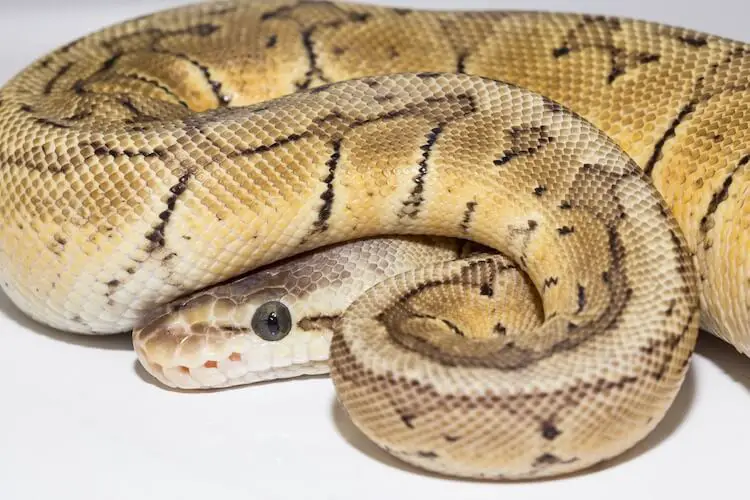
The 2003 Lemon Blast is a clever mix of the codominant Pastel and dominant Pinstripe genes.
This designer morph tends to have fine-lined, complex linear patterns of dark brown and black colors, sometimes with flecks of color scattered around the body.
The base color can be bright yellow to sunset orange with a lighter, pattern less pinstripe along the spine.
This snake is valued for its unique pattern and costs $200 from most breeders.
33. Highway
The Highway pattern is an incredible designer morph created by crossing a Gravel with a Yellow Belly.
Most Highways have a base color of copper-brown to gray-brown, though some can take on a more pastel yellow color. Some are solidly colored along the body and others can have small rings.
Regardless of color, all Highways have a yellow, broken stripe pattern along their spine similar. Some stripes may have a dark shadow around them, emphasizing the bright pattern.
The higher the contrast in the morph, the higher the price. Most are priced between $550 and $650.
34. Dreamsicle
Dreamsicles are highly complex designer ball pythons that require 2-4 generations of breeding to ultimately achieve an Albino-Lavender and Piebald mix.
All three (Albino, Lavender and Piebald) of these genes are recessive, making the morph even harder to produce, though the coloration is well worth it to many breeders.
These snakes are often white or pinkish in color with “pattern-clouds” scattered randomly along their body.
Each blotch is bright orange and well defined, often containing small spots of white as well, a trait not usually observed in normal Piebalds.
They have been one of the most sought-after morphs since 2007 and cost upwards of $2,500.
35. Yellow Belly
The Yellow Belly was first proven in 2003 and is bred from a basic codominant gene.
Yellow Bellies are known for their ability to intensify the color of other morphs when bred together.
They have only subtle differences from normal Ball Pythons. They have a clean, yellowish tint on their bellies and a speckled pattern bordering their scutes. Otherwise, they appear totally normal.
Due to their similar appearance, they cost around $50.
Some Yellow Belly morphs have blushing or flaming along the belly, but this isn’t as common.
36. Woma
The Woma is a basic, dominant gene that was first produced in 1999.
This morph is named for their banding pattern because it mimics the Woma Python.
These snakes have brown sides that gradually lighten towards the spine. Their heads are dark with mild blushing and yellow upper lips. They also have dark bands across their bodies that become thinner towards the belly.
This morph is difficult to breed for two main reasons:
- They produce unpredictable offspring and are therefore hard to use for consistent clutch breeding.
- They can’t be crossbred with themselves, since Super Womas die quickly.
Despite the breeding issues that may occur with this morph they can be purchased for $250.
37. Phantom
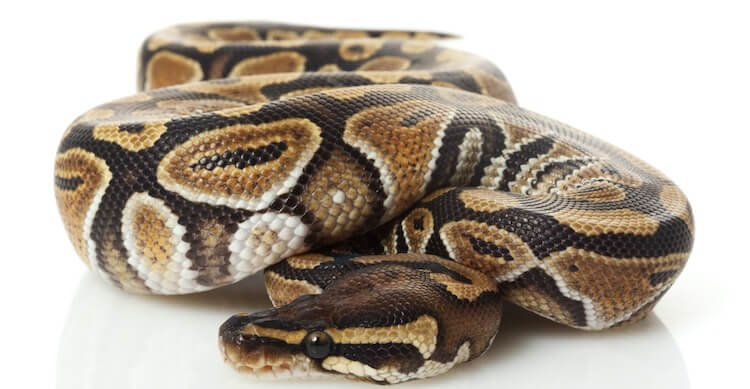
The Phantom ball python possesses a gene that is extremely close, if not the same, as the one that causes the Mystic morph.
Phantoms are mostly kept by breeders because of their codominant traits.
Most of these snakes have a black base color that fades to tan as it approaches a white belly. Their pattern has dark golden-yellow alien heads with black spots. They also have spots along their spine with some striping towards the tail.
An interesting fact about this morph is that although it was proven in 2005, they were actually first produced by accident in 2001 during Ralph Davis’s Goblin morph project. Today, this python can be purchased for $100.
38. Candino
The “Candino” is a mix of the recessive Albino and Candy genes created in 2012.
They are a designer ball python meaning they possess such rare mutations that have an almost 0% chance of occurring in the wild.
They have a light pink or lavender base color and a bright yellow blotched pattern. There is a slight fading around the blotches, highlighting them for a truly spectacular appearance.
To purchase a Candino you should expect to pay $325 or more.
39. Chocolate

Chocolate ball pythons are a basic morph with codominant tendencies.
Recognized as a genetic variant in 1999 these snakes have been consistently popular costing around $100. However, a more intense color pattern may cost as much as $250.
They have dark chocolate-brown base colors with caramel colored keyhole and alien head spots.
Most of the spots have dark centers that are balloon shaped. They also have solid caramel spots along their spines, and their heads appear relatively normal in color and pattern.
40. Spotnose
The Spotnose was first bred in 2005 from a codominant gene.
This morph is named after the prominent circular spots on either side of their nostrils.
When compared with normal variations these snakes have more alien head shapes and have a faded light brown spotting pattern on their head with a dark background.
The Spotnose’s gene only affects the head pattern and facial colors when bred with other morphs, but otherwise has little effect on offspring.
A Spotnose can be purchased for $150.
41. Candy
The Candy ball Python was first recognized in 2009.
They are truly interesting because of their drastic color changes that occur as they age. They are one of few morphs that become more desirable with age, costing around $350.
Candy balls are hatched looking albino, but quickly begin to wash out in color. They start to take on dark lavender, gray, and beige base colors while keeping the bright yellow patterning.
An interesting fact about Candies is that though they possess recessive genes, they display codominant patterns with Albino and Toffee morphs.
Candy and Toffee morphs were caught from the same bush in Africa, stemming controversy about the legitimacy of their morph separation.
42. Tiger
The Tiger is also known as the Desert Enchi.
The origin of this morph is unknown but they are a designer morph bred by combing a dominant Desert gene with a codominant Enchi gene. Tigers are a light yellow color that fades to an orange hue along the sides.
They have dark brown bands across their back with spots and shorter horizontal stripes throughout the pattern. They also have dark heads and noses with lighter portions along the sides of the face and the mouth.
Depending on the intensity of the color and pattern, a tiger morph can be purchased from $200 to $400.
43. Super Blast
The Super Blast is a designer pattern produced by combing a Super Pastel snake with a Pinstripe (3 different genes).
The beautiful Super Blast receives lot of attention from Ball Python fans. Because of their fanfare they currently cost $425.
These snakes are a hazy, bright pastel yellow color. They have thin, faded black vertical lines along the sides of a light-striped spine.
Their face has dark spotting which is an odd trait considering the lighter color of the rest of the body.
44. Acid
The Acid is a new morph that was introduced in 2015.
Since 2015 they have remained especially popular with breeders who have been known to pay up to $1,500 for this snake.
Acid ball pythons have a dark brown or black base color with golden brown spots resembling a broken up normal pattern. Their most interesting feature is their intricately patterned belly. It is yellowish with a black zipper-like line along the entire snake.
The dominant gene responsible for their pattern is one of very few that can overtake an Ivory gene. It’s also known to “shatter” the patterns of any morph it is bred to.
45. Ringer
Ringers are an interesting anomaly found within the world of morph breeding.
They have normal or specific morph patterns and colors, but are roughly 5% Pied (normally in their tail).
These snakes are born to standard Ball Python parents but display a small spot or ring of white near the end of their tail. This small amount of white is called a “ringer” and breeders use them to find snakes that may carry the recessive Pied gene.
The pattern of inheritance is unknown and having a Ringer doesn’t always mean the snake will produce Piebald offspring.
46. Blue-Eyed Leucistic
Blue-Eyed Leucistics are pure white with blue eyes and are extremely rare to find. Their rareness is because of their complex genetic makeup.
They are typically bred from up to five different morphs (Mojave, Lesser, Butter, Russo, and Phantom) and can take 2-4 generations to be produced.
Even after breeding five generations, the odds of some hatchlings being perfect Blue-Eyed Leucistics is unpredictable at best (no clutch is yet to exceed a 25% success rate).
This difficulty in breeding this snake is the main reason they are sold for $800 to $1,000.
47. Fire Ivory (Fire Super Yellow Belly)
Also known as a “Fire Super Yellow Belly,” the Fire Ivory was first bred from Fire and Ivory morphs in 2012.
These snakes cost $375 and are truly unique in appearance.
Ivory ball pythons are a product of two codominant Yellow Belly morphs, making the Fire Ivory a combination of three genes.
They have a pink-lavender base color with gray blushing making them look dirty.
They are patternless expect for a single a yellow stripe along their spine. This unique pattern is exactly what makes them so desirable.
48. Blue-Eyed Lucy
The Blue-Eyed Lucies is another morph with the Blue-Eyed Leucistics complex.
This snake is bred from Mojave and Lesser morphs.
Most Blue-Eyed Lucy morphs have faint yellow dorsal stripes, making them slightly less desirable than their counterparts. However, these snakes still sell for $700.
Unlike other leucistic or albino snakes, their bright eyes experience no excessive light sensitivity.
49. Bongo Pastel
This morph was first bred in 2012 by mating a Bongo with a Pastel morph.
These snakes have a dark brownish-black base color that fades to white along the sides of the belly. Their pattern is similar to a Bongo with reduced markings along the spine and “alien-head” blotches along the sides with black centers.
The Pastel gene, however, increases the contrast by turning the blotches into bright yellow shapes outlined by sections of blushing base colors.
This brightly contrasted snake can be purchased for $300-$500 depending on the quality of the coloration.
50. Ghi Ball Python
Another example of codominant genetics, the Ghi ball python was first discovered in 2007.
They Ghi has a patternless light colored belly and a black base color over their back.
This Ball Python also has patterns of deep orange-brown blotching filled with black spots and specks. Towards the belly, the base color begins to blush or fade in between blotches, and silver flaming can be observed as a lining along the lower edges.
Native to Africa, the Ghi python takes well to captivity and can be purchased for $100.
Summary
Ball Pythons are some of the most incredibly diverse snakes.
Ball Python Morphs are bred to be a variety of unique colors and patterns from beautiful “alien” spots to a completely white body.
These snakes are loved for their tame, gentle demeanor, as well as their amazing patterns.
Whether you are looking for your first snake, or are an experienced herpetologist looking to add some color to your collection, ball pythons are a great snake.
Did any of the Ball Python Morphs in our list catch your eye? Let us know in the comments below.

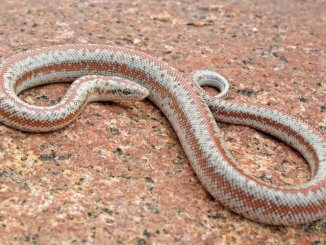
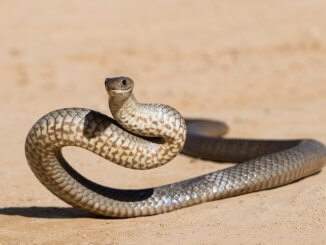
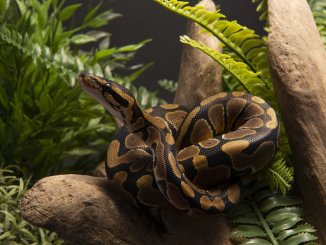

Thanks for all the info it helps new breeders like me. We can compare pictures and read about the actual genetics that make up these beautiful snakes.
I have a lemonblast fire and she is finally ready to breed. I was wondering if anyone had suggestions ot proven outcomes.
You can find a lot of genes-related breeding information on internet. I think people tend to go for Pastel, or Desert Ghost for genes which increase brightness, or Banana for genes which increase the saturation of its background colour. Always breed responsibly to avoid genetic defects and if needed seek professional advice on proven outcomes.